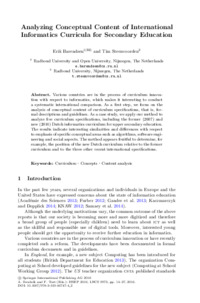Analyzing Conceptual Content of International Informatics Curricula for Secondary EducationErik Barendsen, Tim Steenvoorden
Zu finden in: Informatics in Schools: Improvement of Informatics Knowledge and Perception (Seite 14 bis 27), 2016
  |
 |
 Diese Seite wurde seit 7 Jahren inhaltlich nicht mehr aktualisiert.
Unter Umständen ist sie nicht mehr aktuell.
Diese Seite wurde seit 7 Jahren inhaltlich nicht mehr aktualisiert.
Unter Umständen ist sie nicht mehr aktuell.
 Zusammenfassungen
Zusammenfassungen
 Various countries are in the process of curriculum innovation with respect to informatics, which makes it interesting to conduct a systematic international comparison. As a first step, we focus on the analysis of conceptual content of curriculum specifications, that is, formal descriptions and guidelines. As a case study, we apply our method to analyze five curriculum specifications, including the former (2007) and new (2016) Dutch informatics curriculum for upper secondary education. The results indicate interesting similarities and differences with respect to emphasis of specific conceptual areas such as algorithms, software engineering and social aspects. The method appears fruitful to determine, for example, the position of the new Dutch curriculum relative to the former curriculum and to the three other recent international specifications.
Various countries are in the process of curriculum innovation with respect to informatics, which makes it interesting to conduct a systematic international comparison. As a first step, we focus on the analysis of conceptual content of curriculum specifications, that is, formal descriptions and guidelines. As a case study, we apply our method to analyze five curriculum specifications, including the former (2007) and new (2016) Dutch informatics curriculum for upper secondary education. The results indicate interesting similarities and differences with respect to emphasis of specific conceptual areas such as algorithms, software engineering and social aspects. The method appears fruitful to determine, for example, the position of the new Dutch curriculum relative to the former curriculum and to the three other recent international specifications. Dieses Kapitel erwähnt ...
Dieses Kapitel erwähnt ...
 Tagcloud
Tagcloud
 Anderswo finden
Anderswo finden
 Volltext dieses Dokuments
Volltext dieses Dokuments
 |  Analyzing Conceptual Content of International Informatics Curricula for Secondary Education: Artikel als Volltext bei Springerlink ( Analyzing Conceptual Content of International Informatics Curricula for Secondary Education: Artikel als Volltext bei Springerlink ( : :  , 333 kByte; , 333 kByte;  : :  ) ) |
 Anderswo suchen
Anderswo suchen 
 Beat und dieses Kapitel
Beat und dieses Kapitel
Beat hat Dieses Kapitel während seiner Zeit am Institut für Medien und Schule (IMS) ins Biblionetz aufgenommen. Beat besitzt kein physisches, aber ein digitales Exemplar. Eine digitale Version ist auf dem Internet verfügbar (s.o.). Aufgrund der wenigen Einträge im Biblionetz scheint er es nicht wirklich gelesen zu haben. Es gibt bisher auch nur wenige Objekte im Biblionetz, die dieses Werk zitieren.










 Biblionetz-History
Biblionetz-History